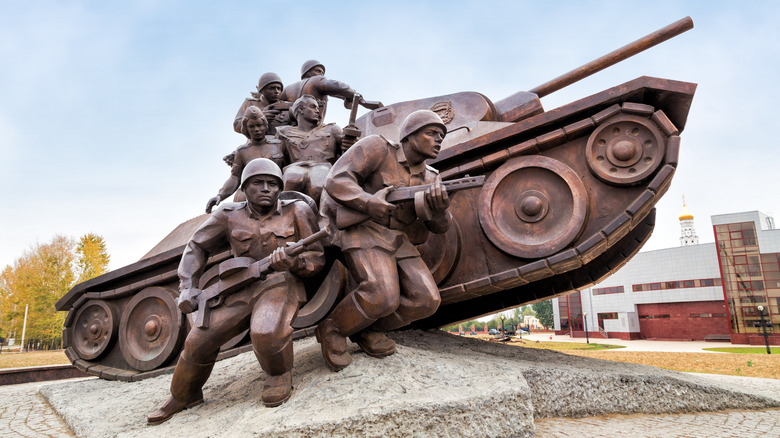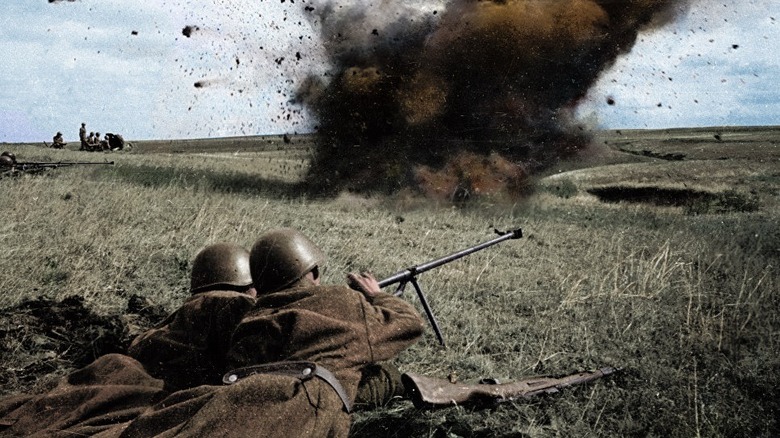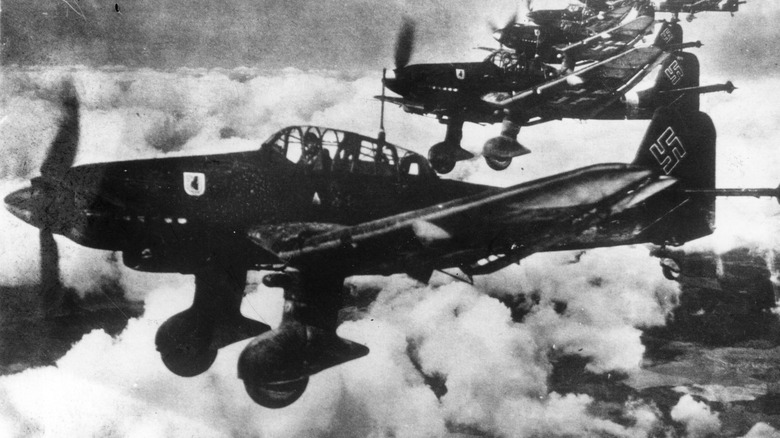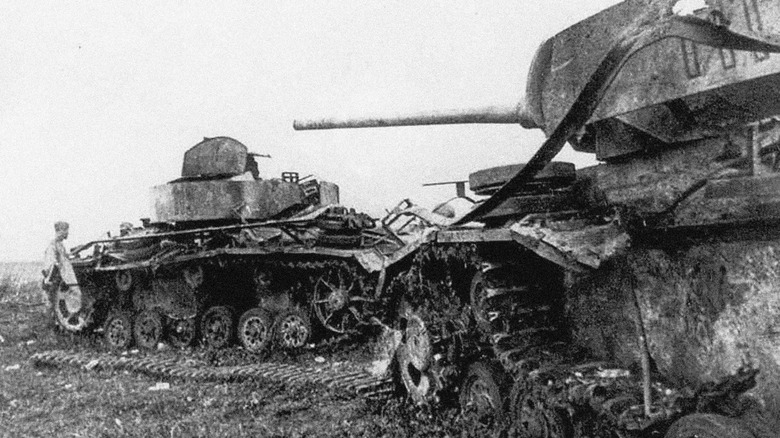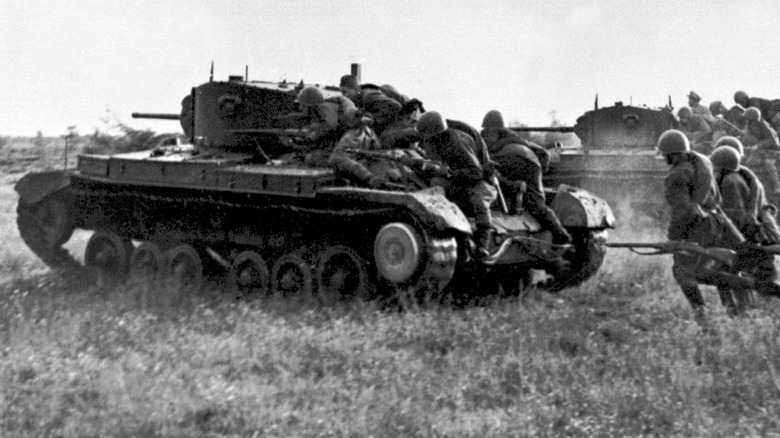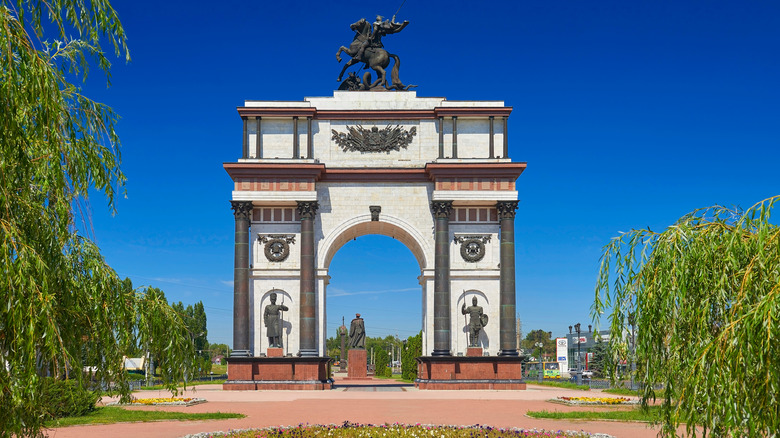The Biggest Tank Skirmish The World Has Ever Seen: The Battle Of Kursk
The conflicts on the Eastern Front of World War II were bloody and brutal. By 1943, the German army had lost millions of soldiers in Russia and resorted to using aging conscripts from World War I and boys of the Hitler Youth to fill this void. Following Operation Barbarossa, Germany's invasion of the Soviet Union, and after its crushing defeat as a result of Hitler's desperate persistence in the Battle of Stalingrad, Stalin's Red Army started its counteroffensive west towards Berlin. At the Battle of Kursk, the Soviet victory ultimately marked the end of the conflict on the Eastern Front and a turning point in World War II.
The events of the summer of 1943 might be seen as Germany's last stand on the Eastern Front in what was already one of the most challenging conflicts ever seen in war. Stalingrad had claimed the lives of over a million Red Army soldiers, and half a million German troops were dead or captured by the time Field Marshall Friedrich Paulus surrendered against Hitler's will. Soon after, the remaining German forces established a new front line stretching from northern Russia to the Black Sea. At its center, surrounding the city of Kursk, was a bulge, or salient, that reached 150 miles from north to south and penetrated 100 miles into German territory.
The Battle of Kursk was staged within the salient, and it will forever be remembered as one of the most significant combined ground and air offenses ever waged, with tanks playing a dominant role. Here, we look at the events leading up to, during, and following the battle of Kursk, the armament of each of the belligerent forces, and its ultimate effect on the outcome of World War II.
The strategic importance of the Kursk salient
In the spring of 1943, the German and Russian Armies had been locked in conflict for almost two years on the Eastern Front and reached an impasse. The salient surrounding the city of Kursk marked a strategic epicenter where vital infrastructure, including roads and railways, met. Holding this territory would allow the Germans ease of movement along the Eastern Front while placing Russia at a vantage point to retake lost territories, including Ukraine.
The Kursk salient would be the decisive point of battle upon the Eastern Front as the Soviet Red Army pushed westwards. Stalin's troops were buoyed by their victory over Germany at Stalingrad while the Axis powers licked their wounds following the bloodshed. Field Marshall Erich von Manstein was commander of the German Army Group South, and his request to attack the salient in a timely manner was unheeded.
This delay gave the Soviet Army, led by General Georgy Konstantinovich Zhukov, time to regroup and resupply. At the same time, both sides waited out the punishing wet and muddy conditions of the Russian spring. By early summer, Hitler and his generals had agreed to launch an offensive on the salient. Operation Citadel, as it was called, was to be a pivotal moment in the campaign in Eastern Europe, and the commanders readied their forces for the coming conflict.
[Featured image by Cassowary Colorizations via Wikimedia Commons | Cropped and scaled | CC BY-SA 2.0]
Preparation for battle
The lull in fighting over the course of the spring had given both German and Russian armies time to amass considerable forces. On the German side were infantry and Panzer divisions consisting of approximately 777,000 troops, 2,500 armored vehicles including tanks, and almost 7,500 artillery pieces. Around 1,800 Luftwaffe aircraft would provide support to the forces on the ground.
The Soviet defenders of the salient had, by this time, rallied their forces to an even greater size. To the north, its numbers comprised over 700,000 troops, with an armament of almost 1,800 tanks and armored vehicles, as well as 12,500 artillery pieces. Meanwhile, in the south, it had over 600,000 soldiers, 1,700 tanks, and nearly 10,000 guns. Incredibly, when combined with its reserve army, the Soviet forces numbered nearly two million soldiers and had around 3,500 aircraft to support its defenses.
The German plan was to encircle the salient, using the Ninth Army to the north and the Fourth Panzer Army and Army Group Kempf to the south. These would operate in a pincer movement to eventually meet up at Kursk, having overwhelmed the surrounded Soviet defenders. Unfortunately for the Axis Powers, the Soviets were wise to their plan, thanks to intercepted intelligence. They heavily fortified the salient before launching a counterattack to decimate the German forces. Due to the nature of the combat and the terrain upon which the battle would be fought, both sides realized that tanks would play a dominant role in achieving their objectives.
[Featured image public domain via Wikimedia Commons | Cropped and scaled]
German tanks used in the Battle of Kursk
Having resupplied its forces, Germany introduced some new armaments to its tank battalions, one of which was the Ferdinand, named after its creator, legendary car designer Ferdinand Porsche. These were later renamed the Elefant and were used with great success as tank destroyers during the battle of Kursk, thanks to their heavy guns that were effective at long range. Unfortunately, they were vulnerable at close quarters due to their lack of machine guns. Of the 90 that were brought to the front lines, just over half survived, but they were nonetheless notorious machines that destroyed hundreds of Soviet tanks.
Kursk's battle also saw the debut of the Panther tank, which was also known as the Panzer V. This was created as an affordable yet formidable foe to rival the Soviet T-34. While the Panther was proven effective, by the time the fighting began, only 200 units were battle-ready. The bulk of the German tank forces would, therefore, comprise the tried-and-true Panzer III and Panzer IV, which had already been used extensively on the Eastern Front and other theaters of World War II.
While the Panzers were highly effective against American and British tanks, they met their match when pitted against the Soviet T-34. With this in mind, the Germans had already developed the Tiger I heavy tank, which would lead the charge against the might of the Red Army, with the Panzers bringing up the rear. However, only around 150 Tigers were available when the battle began.
Soviet tanks used in the Battle of Kursk
As the war raged on, Soviet arms production went into overdrive, producing almost 40,000 tanks and self-propelled gun units by the fall of 1943. The communist war machine was unlike anything seen before and was a significant contributing factor to its success on the Eastern Front. As such, the Red Army was well-prepared, especially given the delays, while Hitler dragged his heels in the spring of 1943.
Soviet tanks used during the battle of Kursk included the KV-1 and the T-70. The KV-1 was a heavy tank at 48 tons and featured thick armor plating, although it featured the same engine as the T-34, which was far more nimble. Conversely, the T-70 was a light tank that made up one-third of the Soviet tank fleet, but it wasn't as practical as the T-34, and its main advantage was that it was relatively inexpensive and quick to manufacture.
The pride of place in the Soviet tank fleet was the T-34. This impressive machine quickly gained legendary status during World War II by consistently proving its value on the Eastern Front, although even this rugged, reliable workhorse was outperformed by the latest Panzers with their tough armor plating. Still, the T-34 was in ready supply and was highly maneuverable, giving it an edge when tackling rugged terrain.
Aerial support in the Battle of Kursk
While historians often focus on the clash of troops on the ground and their mechanized rolling fortresses, air support during the Battle of Kursk was crucial to ensuring success as war raged below. Both Hitler and Stalin had readied considerable aerial forces to battle for control of the air and assist frontline units.
One of the Luftwaffe's most notorious planes in the Battle of Kursk was the Junkers Ju 87, also known as the Stuka, dive bomber. This was especially effective against tanks, as its 110-pound bombs could easily penetrate armor. Aside from the 400 Stukas, the rest of the Luftwaffe forces were made up of Junkers Ju 88 and Heinkel He 111 medium bombers to provide firepower at long range and a fleet of Focke Wulf Fw 190 and Messerschmitt Bf 109 fighter planes.
The Soviets matched these with Ilyushin Il-2 Sturmovik dive bombers, which, unlike the Stukas, were heavily armored. These were supported by Petlyakov Pe-2s dive bombers, which were far more nimble but not as robust. Meanwhile, the capable Yakovyev Yak-1 usually performed fighter duties.
The air battles over Kursk were especially grueling for either side, as planes hammered defenses below while simultaneously trying to blast each other out of the sky. Both Soviet and Luftwaffe forces flew thousands of sorties, but ultimately, the Russians gained the upper hand. With the Soviets' incessant hammering of airborne and grounded planes, coupled with their efficient organization and daily tactical adjustments, the Luftwaffe started to wane. Fuel became scarce and sorties slowed while the tide below began to turn against the Germans.
Operation Citadel and the Battle of Prokhorovka
On the 4th of July, 1943, as Operation Citadel began in earnest, the Soviet forces dug in and prepared to repel the German attackers. The terrain favored the defenders due to the lack of decent roads and a network of rivers that thwarted the attackers' advances. A bad thunderstorm just after the battle commenced swelled the rivers and further impeded the Germans while assisting the Soviets.
After the first day, the Germans had advanced three miles inside the perimeter of the salient on two fronts. The main attack was to occur the next day, July 5th, at 0300 hours, following a massive artillery bombardment to soften up the Soviet defenses. However, the Russians predicted this and unleashed a ferocious salvo of heavy guns the night before, which continued until dawn the following day.
By July 12th, the German Ninth Army to the north had made only seven and a half miles of progress. They were soon repelled from the rear by a significant Soviet counterattack known as Operation Kutuzov, which quashed the German advance in the upper reaches of the salient altogether. Meanwhile, to the south, the Fourth Panzer Army and Army Group Kempf were more successful. They reached the city of Prokhorovka as the Russians called upon reserve forces to confront the attackers.
What followed was one of the largest and most essential actions in the Battle of Kursk. Around 1,500 tanks clashed, including over 100 heavy Tiger I tanks and the agile Panthers fielded by the Germans against the inferior T-34s of the Red Army. Knowing they were outclassed at a distance, the Russian tank brigades threw themselves headlong into the battle, engaging with the Germans at point-blank range. By the end of the melee, around 850 tanks remained undestroyed, and the German forces were left irreparably broken.
Operation Kutuzov
Kutuzov was the name given to the Soviet counteroffensive after the breakdown of Operation Citadel, as the defenders sought to take advantage of the weakened German forces. Named after the Russian General who repelled Napoleon's armies in 1812, this had been the Red Army's plan all along. Now was Stalin's time to retaliate, and what followed was the bloodiest chapter in what was already a desperately violent battle.
Three Soviet army groups prepared to push towards the town of Orel, which lay in the northern part of the salient. It aimed to move southwest and trap the German Ninth Army. Generals Model and von Kluge received intelligence of the Soviet forces amassing to the north, which numbered almost 1.3 million soldiers, 2,400 tanks, 3,000 aircraft, and over 26,000 artillery pieces. It would have been a daunting prospect as they readied their already weary troops for combat once again.
The Germans built up their defenses in preparation, which thwarted the Soviet attackers for a time. However, by day three of the counteroffensive, the Red Army threw its full force against the Germans, while behind the lines, Soviet partisans disrupted supplies by disabling railway networks. It wasn't long before Germany was on the back foot as Russia dominated inside the salient.
By July 26th, two weeks after the start of Operation Kutuzov, the Germans started to retreat. The previously superior Luftwaffe was floundering as the Soviets reclaimed Kharkov (now Kharkiv) in Ukraine. By the time Operation Kutuzov was through, Germany was defeated at the battle of Kursk, and General Zhukov started to push Russia's occupiers back towards the Black Sea.
Aftermath
Since before Operation Barbarossa, Hitler had been obsessed with conquering Russia. So much so that he was prepared to forfeit hundreds of thousands of his soldiers' lives, first in attempting to conquer his adversary's namesake city of Stalingrad and later at the Battle of Kursk. As Napoleon had found in 1812 – when his armies succumbed to disease, challenging logistics, and appalling weather — the Germans' experience was also dismal.
Conservative estimates put German casualties at the Battle of Kursk at around 200,000, with Soviet casualties estimated to be as many as four times that amount. The Germans lost up to 1,600 tanks and artillery, compared to approximately 6,000 on the Soviet side. As despicable as Hitler was, it is also worth considering the actions of Josef Stalin, who was also prepared to sacrifice however many lives it took to achieve his objectives. The Soviet Union recorded losses of 8.7 million military personnel and around 19 million civilian deaths over the course of the war. For perspective, more Soviet soldiers died in the Battle of Kursk alone than American soldiers died in the entirety of World War II.
Russian POWs and soldiers who surrendered were seen as traitors and sent to the Siberian wastelands, where they were put to work in the appalling Gulags alongside German prisoners of war. Meanwhile, defeated Germany lost almost eighty percent of its wartime dead on the Eastern front — four million soldiers out of a total of five million killed.
Victory on the Eastern Front
Hitler had committed his total Eastern Front reserves to the attack on the Kursk salient, and it was a gamble he lost. While Russia also paid a massive price in blood, the Soviet victory changed the course of the war, and the Axis Powers would never recover.
As with the battle of Stalingrad before it, Kursk was ultimately a numbers game, and Stalin was happy to go all in. At that point, Hitler was desperate. His armies were already fighting a war on several fronts, and he had decided to divert resources away from the Eastern Front, as the Battle of Kursk coincided with the Allied invasion of Sicily.
The Allied North Africa Campaign was over, and troops were already on the offensive in southern Europe. Within a year, Operation Overlord would be implemented, and the D-Day landings would herald the large-scale invasion of Northern Europe. Soon after, the allies would race across the continent, with British and American troops pushing from the west and Soviet forces from the east.
From the moment the Red Army made its counteroffensive at the Battle of Kursk, Hitler's days were numbered. While the sacrifices were great, the conflict was ultimately the swansong of the war on the Eastern Front, battering German resolve and paving the way for the Allied advance on Berlin.
